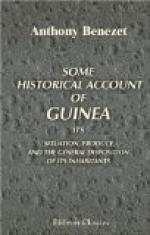[Footnote A: See Travels into different parts of Africa, by Francis Moor, with a letter to the publisher.]
[Footnote B: Ibid.]
[Footnote C: Collection, vol. 1, page 13.]
From the foregoing accounts, it is undoubted, that the practice of making slaves of the Negroes, owes its origin to the early incursions of the Portugueze on the coast of Africa, solely from an inordinate desire of gain. This is clearly evidenced from their own historians, particularly Cada Mosto, about the year 1455, who writes,[A] “That before the trade was settled for purchasing slaves from the Moors at Arguin, sometimes four, and sometimes more Portugueze vessels, were used to come to that gulph, well armed; and landing by night, would surprize some fishermen’s villages: that they even entered into the country, and carried off Arabs of both sexes, whom they sold in Portugal.” And also, “That the Portugueze and Spaniards, settled on four of the Canary islands, would go to the other island by night, and seize some of the natives of both sexes, whom they sent to be sold in Spain.”
[Footnote A: Collection vol. 1, page 576.]
After the settlement of America, those devastations, and the captivating the miserable Africans, greatly increased.
Anderson, in his history of trade and commerce, at page 336, speaking of what passed in the year 1508, writes, “That the Spaniards had by this time found that the miserable Indian natives, whom they had made to work in their mines and fields, were not so robust and proper for those purposes as Negroes brought from Africa; wherefore they, about that time, began to import Negroes for that end into Hispaniola, from the Portugueze settlements on the Guinea coasts; and also afterwards for their sugar works.” This oppression of the Indians had, even before this




